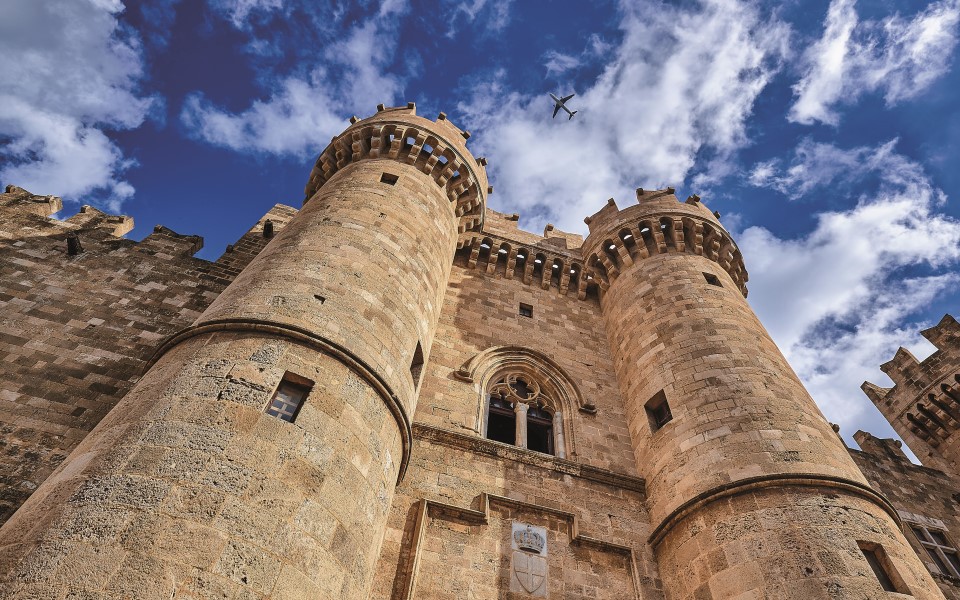It’s evening, and you’re walking along the medieval Street of the Knights in the Old City of Rhodes. The beautiful cast-iron street lamps illuminate the stone-built inns of the different tongues of the Knights of the Order of St John.
You can still make out the crests above each door, and it’s as if you’ve been beamed back in time to the Middle Ages.
Or maybe it’s afternoon and you’re looking for the Turkish café on Sokratous Street, the Old City’s main shopping street, aware at the same time that every inhabitant of the city since 408BC onwards has taken this route, too; the road on which you’re walking was originally laid out based on designs made by the ancient urban planner Hippodamus of Miletus.
It could be that you’re standing at the top of Mt Filerimos at Ialysos, with monuments from every period all around you, and suddenly you feel the same excitement that Suleiman the Magnificent experienced here in 1522, as he commanded the attacks that captured the island for him.
You might be swimming in the emerald waters off Anthony Quinn Beach, and get the feeling that you’re taking part in the movie “The Guns of Navarone,” filmed here in 1961.
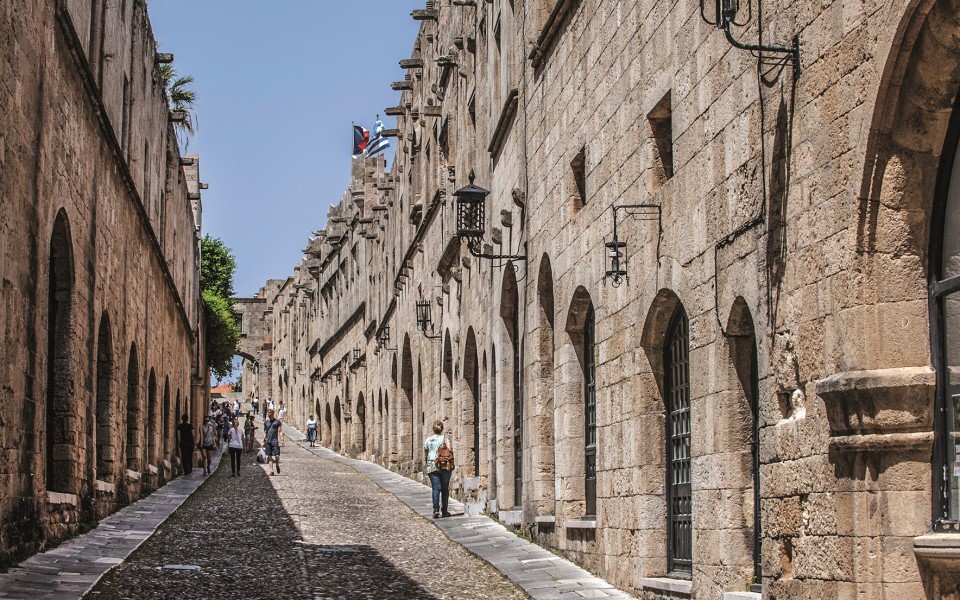
© Clairy Moustafellou
This constant dualism of time, where the body is in the present and the mind travels back into the past, and this constant sense of a divided self which, instead of confusing you, helps you acquire a new perspective, is what transforms Rhodes from a crowded tourist destination with restaurant display cases full of pre-cooked food into an enchanting time capsule with enough space for every unrequited wish.
Rhodes, the largest of the islands of the Dodecanese, has been the object of desire for scores of conquerors, from the Persians in the Archaic period to the Italians in the twentieth century.
Everything that a demanding traveler might hope to discover has been given a place on its fertile soil, among orange orchards, olive groves and vineyards: ruins and monuments from every age, lively villages boasting traditional architectural styles and rich cultural legacies, locations of incomparable natural beauty, and landmark gastronomic establishments.
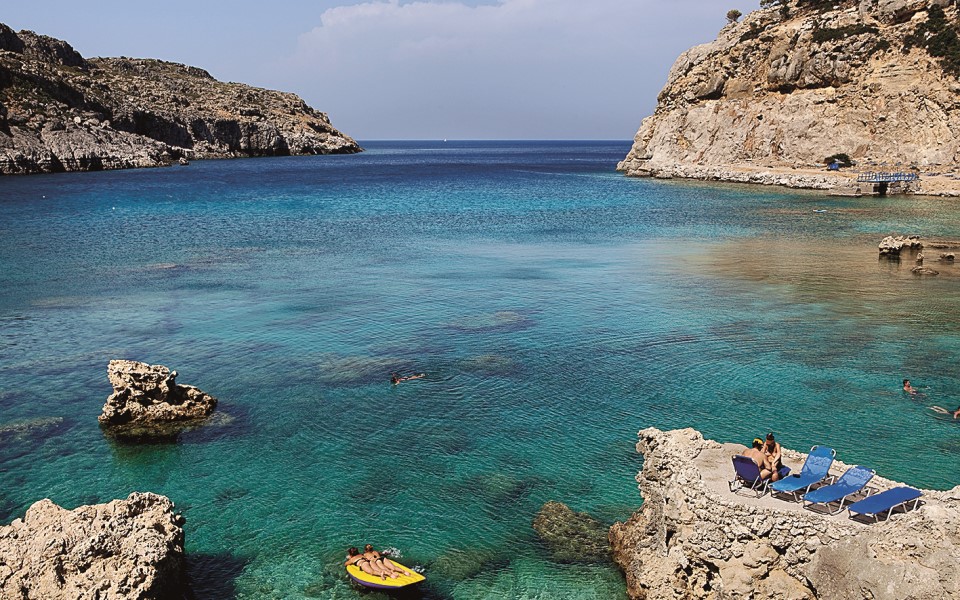
© Perikles Merakos
THE IRRESISTIBLE EAST COAST
As I head down the island’s east coast from the city of Rhodes towards the beautiful and eminently instagrammable Prasonisi, an islet connected to Rhodes by the narrowest of sandy roads that’s gobbled up every winter by the tides, there is simply no way of counting the stops that I can make.
I decide to leave the mineral springs of Faliraki and the natural “armchairs” formed by the rocks on Anthony Quinn Beach (how wonderful it would be if there were no sun loungers here!) for another time, and make a bee-line instead for the village of Afantou.
This white village, as delightful as its famous apricots, was built behind low hills so as to be imperceptible from the sea and therefore protected from pirates. I sunbathe to my heart’s content on its vast, uncrowded beach.
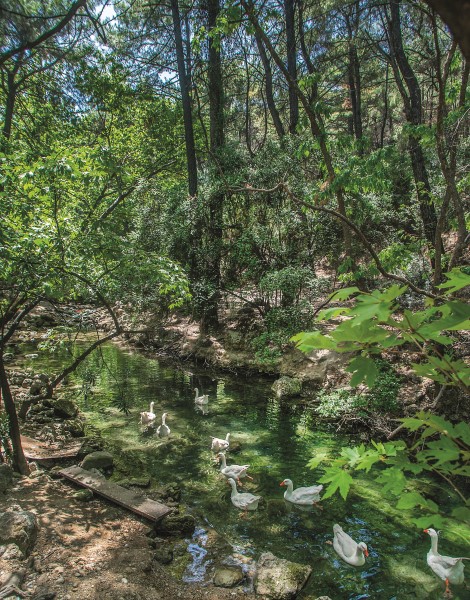
© Clairy Moustafellou
I then drive onwards towards my beloved village of Kolympia, an agricultural settlement built by the occupying Italian forces (they called it the Rural Village of San Benedetto) as a home for Italian colonists.
The two bays here, with their fishing boats and sailing yachts, are perfect for swimming and for underwater exploration. At midday, on the way to Archipoli, I stop to enjoy the cool shade of the Seven Springs (Epta Piges). Around a dam built by the Italians to provide Kolympia with water stretches a green oasis with giant plane trees, lithe pine trees and streams.
I take off my shoes, turn on my phone’s flashlight, and walk in a stream through a narrow, roughly 150m-long dark tunnel in order to reach a secret lake with crystalline waters. The icy water makes my skin tingle.
After this invigorating dip, I return to Kolympia for a meal at Nisaki, a fish taverna with tables almost touching the sea. There’s local Aigaion ouzo in my glass, seafood meze on my plate, and a sky with myriad colors. It’s pure perfection.
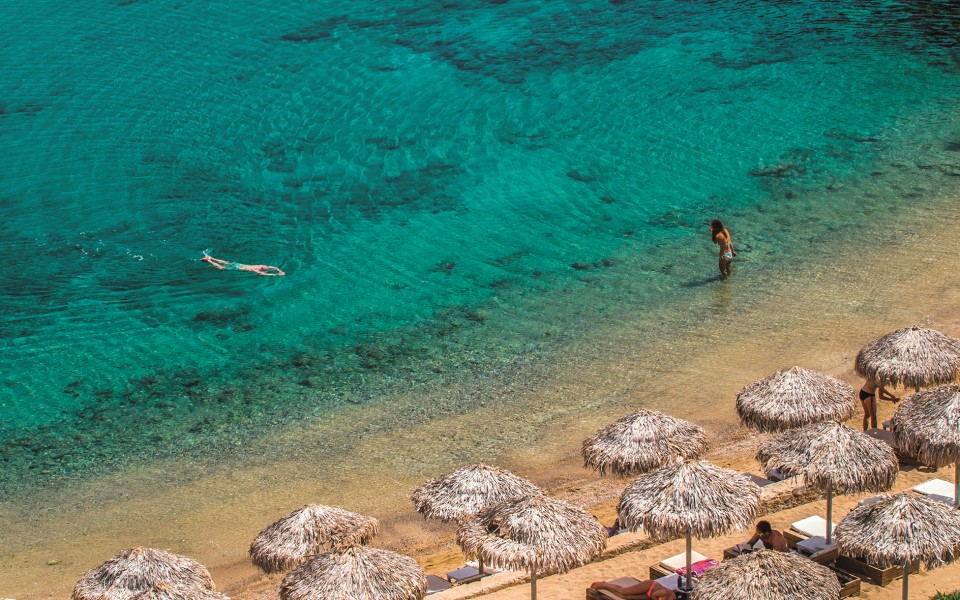
© Clairy Moustafellou
Another attractive village near here is Haraki, south of Kolympia. This old fishing village, with the medieval castle of Feraklou towering over the bay, has a spectacular sandy beach, that of Aghia Agathi, right below the monastery of the same name.
Then comes Lindos, the star of Rhodes dressed all in white. I take a long swim at St Paul’s Bay, where it’s said that St Paul disembarked after a sea voyage from Miletus in Syria.
Then it’s an afternoon stroll to see the captains’ stately houses with their inner courtyards, followed by an ascent to the acropolis here in order to capture an unforgettable sunset before heading off for a meal at the timeless eatery Mavrikios. The two brothers who run it are unyielding in their determination to serve a world-class menu rooted in local tradition.
The east coast doesn’t stop at Lindos. On those days when I’m in the mood for a long drive, I set course for the village of Lahania and, more precisely, for the beach bar-restaurant Mea Terra.
The menu’s high quality, from the superb coffee to the fresh fish and the sophisti – cated cocktails, and the boho-Cycladic decor make this friendly hangout on the beach an enticing destination.
I start off with a glass of juice and some reading on a sun lounger, and end up dining on seafood under the stars, still in my bath – ing suit.
When I’m in the mood for a bit more adventure, I drive for 85km (which, given the usual summer seaside traffic, is a roughly two-hour journey) in order to set up camp on Mavros Cavos, a beach with golden sand dunes, prickly cedar trees and shallow waters.
I coat myself with loads of sunscreen because the sun is desert-hot, plant my beach parasol and put the fruit in the shade and the water flasks in the sea to keep them cool.
Then I find an opponent and we play beach paddleball in the sand until I can barely stand from exhaustion.
A stroll in the old city
I always go to the Old City in the evening, when its sites are closed and I don’t have to fight hordes of tourists. I usually enter this UNESCO-designated Monument of World Cultural Heritage from the d’Amboise Gate on the city’s west side. From there, I follow the labyrinthine fortifications before emerging at the Palace of the Grand Master of the Knights of Rhodes where, passing through St Anthony’s Gate, I reach the Street of the Knights. I leave the ruins of the Church of St John of the Collachium, protector saint of the Order, behind and stop for a while to look at the people strolling about the lanes around Sokratous Street. I also say a prayer outside Aghios Fanourios, the saint who helps you find what you’re searching for, before ending up in the courtyard of Hatzikelis Sea Food Restaurant, next to the Church of Panaghia tou Bourgou. If I had just one night to spend on Rhodes, I’d spend it here. At the heart of the Old City, surrounded by cypress trees, flower pots with geraniums, and the lights strung above the dining area, I’d sit, eat seafood delicacies and talk about things yet to come over an icy glass of Athiri wine.
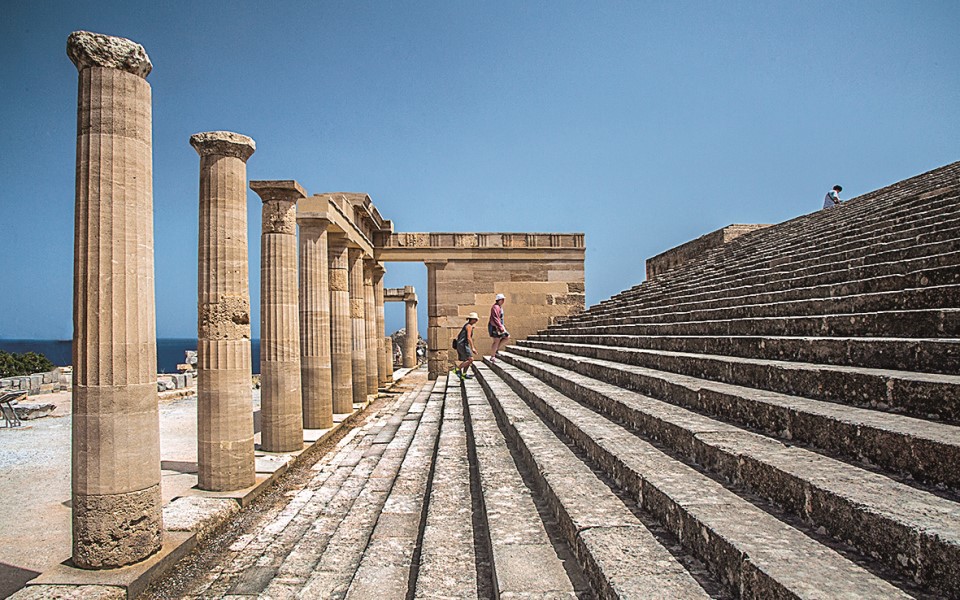
© Clairy Moustafellou
THE ANTIQUITIES OF THE WEST COAST
Ialysos and Kameiros dominate the west coast of Rhodes, which has fewer beaches and is more exposed to the etesian winds. In 408 BC, both these cities came together with Lindos to build the city of Rhodes.
These days I visit Ialysos, now full of tourist complexes, mostly in the afternoon; I come for the incredible view at the end of the cobbled Street of Martyrdom (which starts across from the Monastery of Panaghia Filerimo), where hundreds of birds sing in the shadows of bronze representations of the Stations of the Cross, all leading up to the great cross itself, which is 18m high.
I’m careful as I climb up the very narrow spiral staircase within the cross, as it tends to get crowded, but the endless view always compensates for those few minutes of claustrophobia.
In contrast to busy touristic Ialysos, the ancient city of Kameiros, 33km further to the south, is a serene place. The archaeological site here features the ruins of a very well-preserved ancient settlement with three distinct levels.
Down at Scala, the harbor of the ancient city, I know I’ll find fresh fish and lobsters at the quiet little seaside tavernas, which all look like they’re straight out of a classic black-and-white Greek movie.
As interesting as Kameiros is Monolithos, a village that rises amphitheatrically on the slopes of Mt Akramyti. The castle, dating from the 15th century and perched on the top of a precipitous rock (the name “Monolithos” means “single rock”), is one of the best places on Rhodes from which to watch the sunset.
Straight downhill, roughly 5km away by road, is the hidden beach of Fourni. The drive down is laborious, but the destination affords me the pleasure of solitary swimming and aquamarine tranquility.
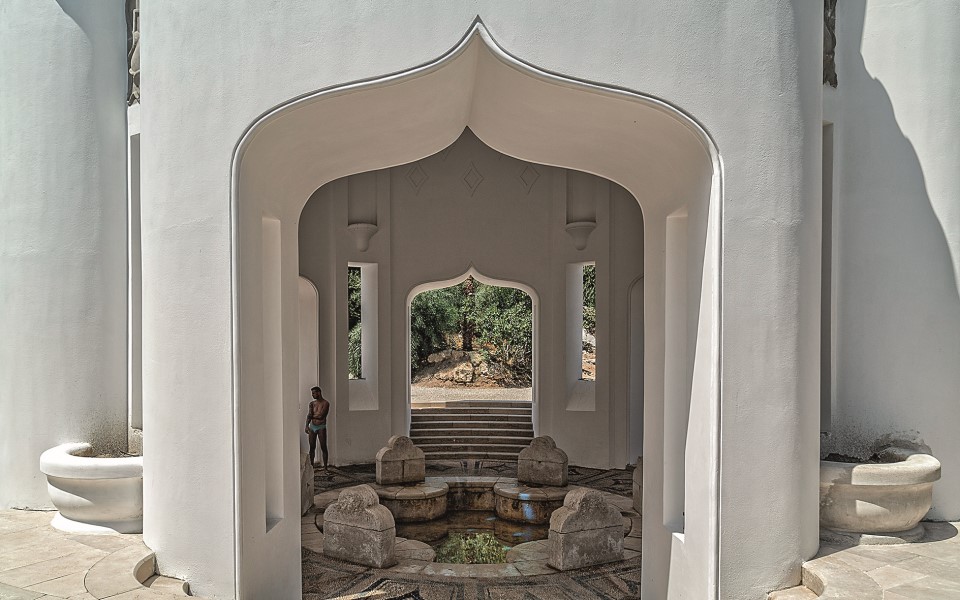
© Perikles Merakos
WINE COUNTRY
In the inland area around Embonas, the island’s wine-making region at the foot of Mt Attavyros, there are four wineries in operation: Emery, Alexandris, Kounakis and Merkouris.
In this vinicultural zone, you’ll find grape varieties such as Athiri and Amorgiano, both used in making Rhodes’ PDO wines. Whenever I come here, I make sure to pick up some bottles for home before visiting Bakis Taverna for well-cooked meat dishes and some souma (a strong spirit derived from figs).
Needless to say, the interior of Rhodes isn’t just a timeless homage to Dionysus. I often head to the village of Apollona for peace and quiet.
Walking through this village, with its single-storied houses with roofs made from patelia, a type of clay good for waterproofing, soothes me, as do the delicious dishes at the traditional eatery Paranga.
For a very different experience, I head down the hill to the Adventure Park at the Apolakkia dam, where I go kayaking on the artificial lake, test my archery skills and hike through the woods in order to shed the pounds I’ve put on over the previous days.

